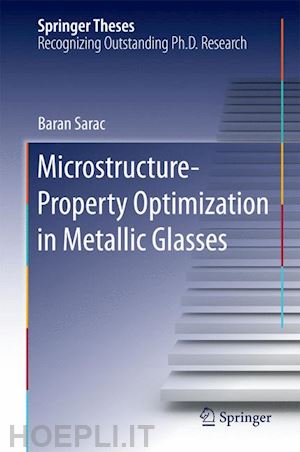
Questo prodotto usufruisce delle SPEDIZIONI GRATIS
selezionando l'opzione Corriere Veloce in fase di ordine.
Pagabile anche con Carta della cultura giovani e del merito, 18App Bonus Cultura e Carta del Docente
Dr. Baran Sarac received his B.S. degree in metallurgical and materials engineering and mechanical engineering from Middle East Technical University, Ankara, Turkey. He has completed his masters and doctorate degree in the Department of Mechanical Engineering and Materials Science at Yale University, New Haven, CT, under the mentorship of Prof. Jan Schroers. He worked successively as a postdoctorate researcher in Helmholtz Zentrum Geesthacht for one year, and has recently embarked on his new position at Leibniz Institute, IFW Dresden with the same title on mechanical and functional characterization of smart alloy systems. His other research interests include structural design, thermoplastic forming, in-situ testing and morphological characterization of advanced cellular structures, as well as numerical simulations of superplastic materials via finite element analysis.
Through his studies at Yale University, Dr. Sarac has been entitled to several esteemed awards, including 2013 Yale University Harding Bliss Prize owing to his contributions to further the intellectual life of the Yale School of Engineering & Applied Science, Pierre W. Hoge fellowship (between 2008-2009), and 2012 Materials Research Society Fall Best Poster Award. His publications have appeared in peer reviewed international journals such as Nature Communications, Advanced Functional Materials, Acta Materialia, Materials Letters, Scripta Materialia, and Journal of Microelectromechanical systems (IEEE), where he was concomitantly involved in federal research projects of DARPA and US Department of Energy.











Il sito utilizza cookie ed altri strumenti di tracciamento che raccolgono informazioni dal dispositivo dell’utente. Oltre ai cookie tecnici ed analitici aggregati, strettamente necessari per il funzionamento di questo sito web, previo consenso dell’utente possono essere installati cookie di profilazione e marketing e cookie dei social media. Cliccando su “Accetto tutti i cookie” saranno attivate tutte le categorie di cookie. Per accettare solo deterninate categorie di cookie, cliccare invece su “Impostazioni cookie”. Chiudendo il banner o continuando a navigare saranno installati solo cookie tecnici. Per maggiori dettagli, consultare la Cookie Policy.